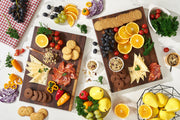
In the bustling world of the kitchen, where culinary creations come to life, there’s one unsung hero that silently supports every chop, slice, and dice—the cutting board. While often overlooked, this humble yet essential tool plays a pivotal role in food preparation. In this blog post, we’ll explore the significance of a cutting board in the kitchen and highlight its various types, materials, maintenance tips, and the importance of using separate boards for different food items.
The Versatile Companion
Whether you’re an amateur cook or a seasoned chef, a reliable cutting board is a must-have in any kitchen. It provides a sturdy and secure surface for various food preparation tasks, ensuring safety, efficiency, and precision. From chopping vegetables and fruits to deboning meats and filleting fish, the cutting board acts as a reliable companion, protecting your countertops and enhancing your culinary skills

Different Types of Cutting Boards
a. Wooden Cutting Boards: Renowned for their natural aesthetic appeal and durability, wooden cutting boards are a popular choice among chefs. They are gentle on knives, reducing the likelihood of dulling the blade. However, they require proper maintenance, such as regular seasoning and oiling, to prevent bacterial growth.
b. Plastic Cutting Boards: Plastic boards are lightweight, affordable, and easy to clean. They come in a variety of colors, reducing the risk of cross-contamination when used for different food items. However, they tend to develop deep grooves over time, providing a breeding ground for bacteria, and may need to be replaced more frequently.
c. Bamboo Cutting Boards: Known for their eco-friendliness and hardness, bamboo cutting boards are an excellent alternative to traditional wooden boards. They possess natural antimicrobial properties and are resistant to knife marks. Regular oiling and handwashing are necessary to maintain their longevity.
d. Glass Cutting Boards: While glass cutting boards are visually appealing and easy to clean, they can be hard on knives, leading to premature dulling. Moreover, their rigid surface does not absorb impact, causing slippage and potential accidents. Hence, glass cutting boards are best suited for serving or as a decorative display.

To maintain optimal food safety, it’s crucial to use separate cutting boards for different food groups. Cross-contamination can occur when bacteria from raw meat, poultry, or seafood come into contact with ready-to-eat foods like fruits, vegetables, or bread. To prevent this, designate specific boards for specific tasks, and consider color-coding them to avoid confusion
In the culinary realm, where precision and cleanliness are paramount, the cutting board emerges as an indispensable tool. From its reliable support during food preparation to its role in promoting food safety, this unassuming kitchen workhorse plays a vital role in every cook’s arsenal.







